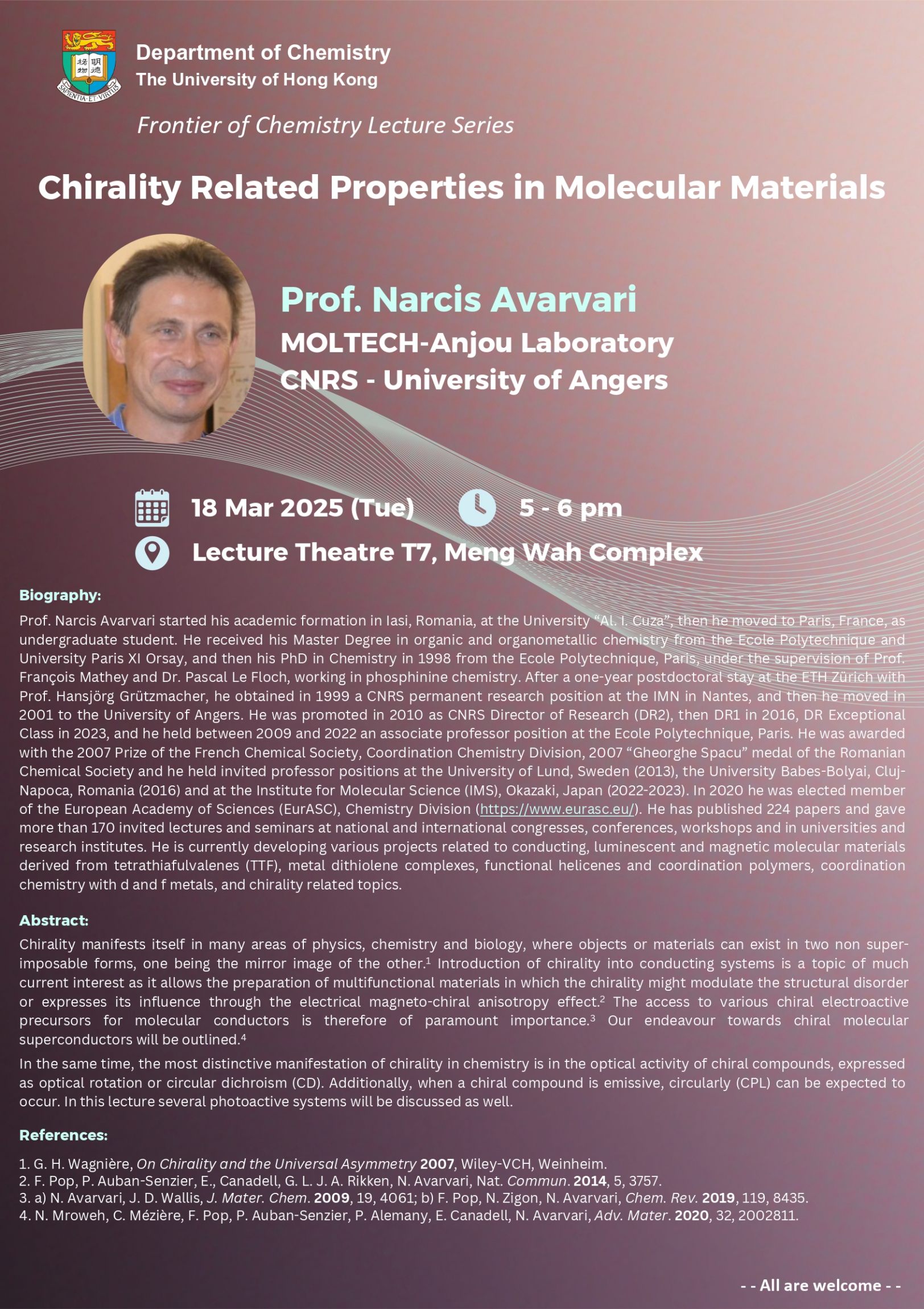Title:
Chirality Related Properties in Molecular Materials
Schedule:
Date: 18thMarch, 2025 (Tuesday)
Time: 5 - 6 pm (HKT)
Venue: Lecture Theatre T7, Meng Wah Complex
Speaker:
Prof. Narcis Avarvari
MOLTECH-Anjou Laboratory
Centre national de la recherche scientifique (CNRS)
University of Angers
Biography:
Prof. Narcis Avarvari started his academic formation in Iasi, Romania, at the University “Al. I. Cuza”, then he moved to Paris, France, as undergraduate student. He received his Master Degree in organic and organometallic chemistry from the Ecole Polytechnique and University Paris XI Orsay, and then his PhD in Chemistry in 1998 from the Ecole Polytechnique, Paris, under the supervision of Prof. François Mathey and Dr. Pascal Le Floch, working in phosphinine chemistry. After a one-year postdoctoral stay at the ETH Zürich with Prof. Hansjörg Grützmacher, he obtained in 1999 a CNRS permanent research position at the IMN in Nantes, and then he moved in 2001 to the University of Angers. He was promoted in 2010 as CNRS Director of Research (DR2), then DR1 in 2016, DR Exceptional Class in 2023, and he held between 2009 and 2022 an associate professor position at the Ecole Polytechnique, Paris. He was awarded with the 2007 Prize of the French Chemical Society, Coordination Chemistry Division, 2007 “Gheorghe Spacu” medal of the Romanian Chemical Society and he held invited professor positions at the University of Lund, Sweden (2013), the University Babes-Bolyai, Cluj-Napoca, Romania (2016) and at the Institute for Molecular Science (IMS), Okazaki, Japan (2022-2023). In 2020 he was elected member of the European Academy of Sciences (EurASC), Chemistry Division (https://www.eurasc.eu/). He has published 224 papers and gave more than 170 invited lectures and seminars at national and international congresses, conferences, workshops and in universities and research institutes. He is currently developing various projects related to conducting, luminescent and magnetic molecular materials derived from tetrathiafulvalenes (TTF), metal dithiolene complexes, functional helicenes and coordination polymers, coordination chemistry with d and f metals, and chirality related topics.
Abstract:
Chirality manifests itself in many areas of physics, chemistry and biology, where objects or materials can exist in two non super-imposable forms, one being the mirror image of the other.1 Introduction of chirality into conducting systems is a topic of much current interest as it allows the preparation of multifunctional materials in which the chirality might modulate the structural disorder or expresses its influence through the electrical magneto-chiral anisotropy effect.2 The access to various chiral electroactive precursors for molecular conductors is therefore of paramount importance.3 Our endeavour towards chiral molecular superconductors will be outlined.4
In the same time, the most distinctive manifestation of chirality in chemistry is in the optical activity of chiral compounds, expressed as optical rotation or circular dichroism (CD). Additionally, when a chiral compound is emissive, circularly (CPL) can be expected to occur. In this lecture several photoactive systems will be discussed as well.

